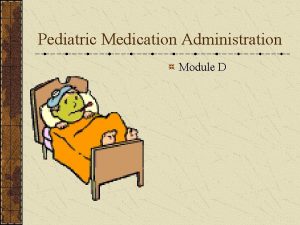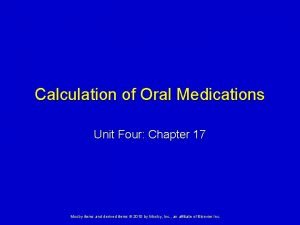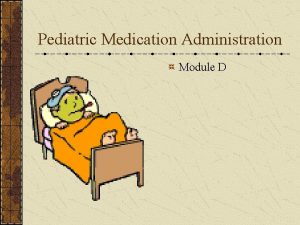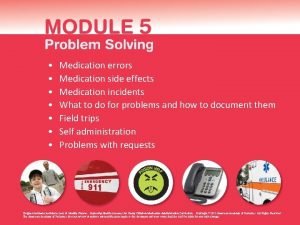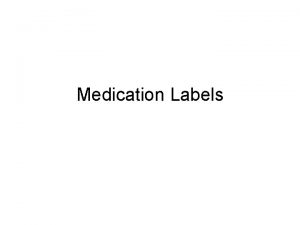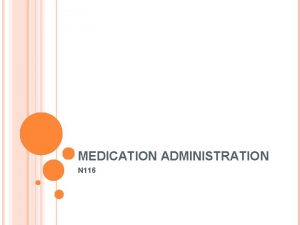Pediatric Medication Administration Module D Pediatric Classifications Age













- Slides: 13

Pediatric Medication Administration Module D

Pediatric Classifications Age Range Classifications < 38 weeks gestation Premature infant < 1 month- <1 year Neonate or newborn infant Infant 1 year - < 12 years Child

Pediatric Considerations Absorption Distribution Metabolism Excretion or elimination

Pediatric Considerations Lack many of the Protective Mechanisms - thin & permeable skin - lacks gastric acid - lacks lung mucosal barriers - poorly regulated body temp. - immature liver & kidney

Factors for IM Site Selection. Peds Avoid nerves and vessels Less SC thickness Muscle mass appropriate to med. Volume Ease of access or position Ventrogluteal-site of choice if >7 mo. Old Vastus Lateralis- site of choice for infants < 12 mo. receiving immunizations Deltoid- Not used in infants or children with underdeveloped muscles. May be used for toddlers and older children.

Medication Administration Techniques Oral Topical Parenterals

Preparing dosages for Pediatric Clients Milligrams/kilograms/ body weight Body surface area Safe dosage range

Milligrams/kilograms/body weight This is the most common method used for calculating pediatric dosage It is based on the client’s weight.

Body surface area Formula: BSA(m 2)/1. 73 (m 2) x Adult dose = Child’s dose Nomogram- see diagram

Safe dosage range Step 1: Calculate the total daily dosage Step 2: Dividing by the number of doses per day.

Other Formulas Used in Pediatric Dosage Calculation Young’s Rule Clark’s Rule Fried’s Rule

Always remember The 6 Rights of Medication Administration The Process of Administering Medication - Identify the client - Inform the client - Administer the drug - Provide adjunctive interventions as needed - Record the drug administered drug - Evaluate the client’s response to drug • Never allow someone else to draw-up your meds • Always practice universal precaution

 Volutrol administration set
Volutrol administration set Pediatric medication administration guidelines
Pediatric medication administration guidelines Iron age dates
Iron age dates Iron age bronze age stone age timeline
Iron age bronze age stone age timeline Medsafe houston
Medsafe houston Therapeutic class and pharmacologic class
Therapeutic class and pharmacologic class Concepts of medication administration pretest
Concepts of medication administration pretest Ear instillation
Ear instillation 8 rights of medication administration
8 rights of medication administration Macy catheter medication administration
Macy catheter medication administration Closed loop medication administration safety initiative
Closed loop medication administration safety initiative Chapter 17 dosage calculation and medication administration
Chapter 17 dosage calculation and medication administration Ati injectable medication administration posttest
Ati injectable medication administration posttest Pill identifier
Pill identifier

